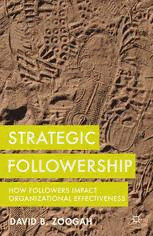
Strategic Followership: How Followers Impact Organizational Effectiveness PDF
Preview Strategic Followership: How Followers Impact Organizational Effectiveness
Strategic Followership AlsobyDavidB.Zoogah ManagingOrganizationalBehaviorintheAfricanContext Strategic Followership How Followers Impact Organizational Effectiveness David B. Zoogah STRATEGICFOLLOWERSHIP Copyright©DavidB.Zoogah,2014. Softcover reprint of the hardcover 1st edition 2014 978-1-137-35621-5 Allrightsreserved. Firstpublishedin2014by PALGRAVEMACMILLAN® intheUnitedStates—adivisionofSt.Martin’sPressLLC, 175FifthAvenue,NewYork,NY10010. WherethisbookisdistributedintheUK,EuropeandtherestoftheWorld, thisisbyPalgraveMacmillan,adivisionofMacmillanPublishersLimited, registeredinEngland,companynumber785998,ofHoundmills, Basingstoke,HampshireRG216XS. PalgraveMacmillanistheglobalacademicimprintoftheabove companiesandhascompaniesandrepresentativesthroughouttheworld. Palgrave®andMacmillan®areregisteredtrademarksintheUnited States,theUnitedKingdom,Europeandothercountries. ISBN 978-1-349-67550-0 ISBN 978-1-137-35442-6 (eBook) DOI 10.1057/9781137354426 LibraryofCongressCataloging-in-PublicationData Zoogah,DavidB. Strategicfollowership:howfollowersimpactorganizational effectiveness/DavidB.Zoogah. pages cm Includesbibliographicalreferencesandindex. 1. Followership. 2. Organizationaleffectiveness. I. Title. HD57.8.Z662015 302.3(cid:2)5—dc23 2014019680 AcataloguerecordofthebookisavailablefromtheBritishLibrary. DesignbyIntegraSoftwareServices Firstedition:November2014 10 9 8 7 6 5 4 3 2 1 DedicatedTo Suakamane,mywonderfulMother,whoseteachingswerearrestedbyher untimelydeparture.Mayhercontinuedguidancesustainandprotecther grandchildren,ConiahandJalen,intheirjourneytowardtheglorious summitshedreamedforthem! Contents ListofFigures ix ListofTables xi Preface xiii Acknowledgments xvii Part I Background Introduction 3 1 TheoreticalPerspectivesofStrategicBehavior 17 2 Followership 39 Part II StrategicFollowership 3 StrategicFollowershipFramework 61 4 RestorativeFollowership 89 5 TranscendentFollowership 127 Part III Extensions 6 NeuralBasisofStrategicFollowership 157 7 VirtuousFollowership 175 8 ManagerialImplications 191 Notes 199 Bibliography 205 Index 221 Figures I.1 Domainsofstrategicfollowership 12 1.1 Integratedmodelofstrategicfollowership 32 1.2 Decisiontreeofstrategicaction 35 2.1 Paretoefficiencyfrontierinthecontextofstrategicfollowership 50 2.2 Structuresoffollowership 52 3.1 Strategicfollowershipframework 64 3.2 Modelsofstrategicfollowershipdecision-making 70 3.3 Dimensionsofstrategicaction 83 4.1 Stagesofrestorativevalue 91 4.2 Relationalanchorage 93 4.3 Restorativestates 95 5.1 Valuecurveoftranscendentfollowership 133 5.2 Typesoftranscendentfollowers 137 6.1 Relationshipbetweenseparationandintegrationstrategies 159 6.2 Modelofdualsituations,neuralprocesses,and strategicbehavior 161 6.3 Attentionalfocusandstrategicbehavior 164 6.4 Neuromodulationofstrategicfollowership 167 6.5 Frontiersofstrategicvalue 172 7.1 Typologyoffollowervirtuesandcapacities 178 Tables 2.1 Equalityparadigm 40 2.2 ErrorsinFollowers’Choices 43 3.1 Strategicbehaviorsandtheirfunctions 79 3.2 Differencesbetweenstrategicleadershipand strategicfollowership 85 4.1 Illustrativecaseofkinshipstate 98 4.2 Illustrativecaseofclanstate 101 4.3 Illustrativecaseofcompanionstate 105 4.4 Illustrativecaseofalliancestate 108 4.5 Strategicdecision-makinginthecontextofnegativedeviance 112 5.1 Summarizedattributesofexemplaryemployeesfrom somecompanies 128 8.1 Howmanagersfacilitatestrategicfollowership 192 Preface Although followership is the complement to leadership, there are sparingly fewerstudies of followership. As many scholars have lamented, followership is as important to organizations as leadership. It is there- fore unfortunate that a complement to strategic leadership has hitherto beenlackingintheliterature.Thepurposeofthisbookistofillthisvoid. I introduce strategic followership because followers can contribute value whentheyexecutetheirroles.Idiscussfourmajorareasofstudyforthose interested in strategic followership: restorative, transcendent, neuronal, andvirtuous.Thestrategicvalueoffollowerscanbeexaminedfromthese areas.Ineacharea,therearespecificdomainsthatcanbeexamined.The followershipsituations,termedstrategicsituations,alongwiththestrate- gicdiscernmentordecision-makingprocesses,strategicroles,andstrategic actions can be examined within the context of restorative, transcendent, neuronal,andvirtuousfollowership. Mygoalinwritingthebookistwofold.First,Iwanttoencouragemore researchinfollowership,especiallyfromthestrategicperspective.Follow- erscancontributemeaningfullytoorganizations’strategicgoalsinmuch thesamewaythatexecutivesdo.Second,Iwantedabookthatreflectsboth the“ailing”and“healthy”aspectsofleadership.ThatiswhyIdidnotelab- orateonthe“normal”stateorwhatthestrategicfollowershipframework termsmaintenance.Extantresearchandotherbookshaveexaminedthat state.Inothertobridgetheresearch-practicegap,Idevotethelastchapter todiscusshowmanagerscanestablishmechanismsthatfacilitatestrategic followership.Withoutsuchmechanisms,followerscannotcreatestrategic value.Thebookcanassistinthatregard. The ability of managers to understand, explain, and predict strate- gic behavior of followers enables them to effectively manage follower activities. After providing a background to strategic followership in the first part of the book, I discuss the two major aspects of strategic followership—restorative and transcendent. I then discuss extensions— neuro-followership and virtuous followership. What are the processes of strategic followership? What drives strategic followership? What are the outcomes of strategic followership? These questions and several others
